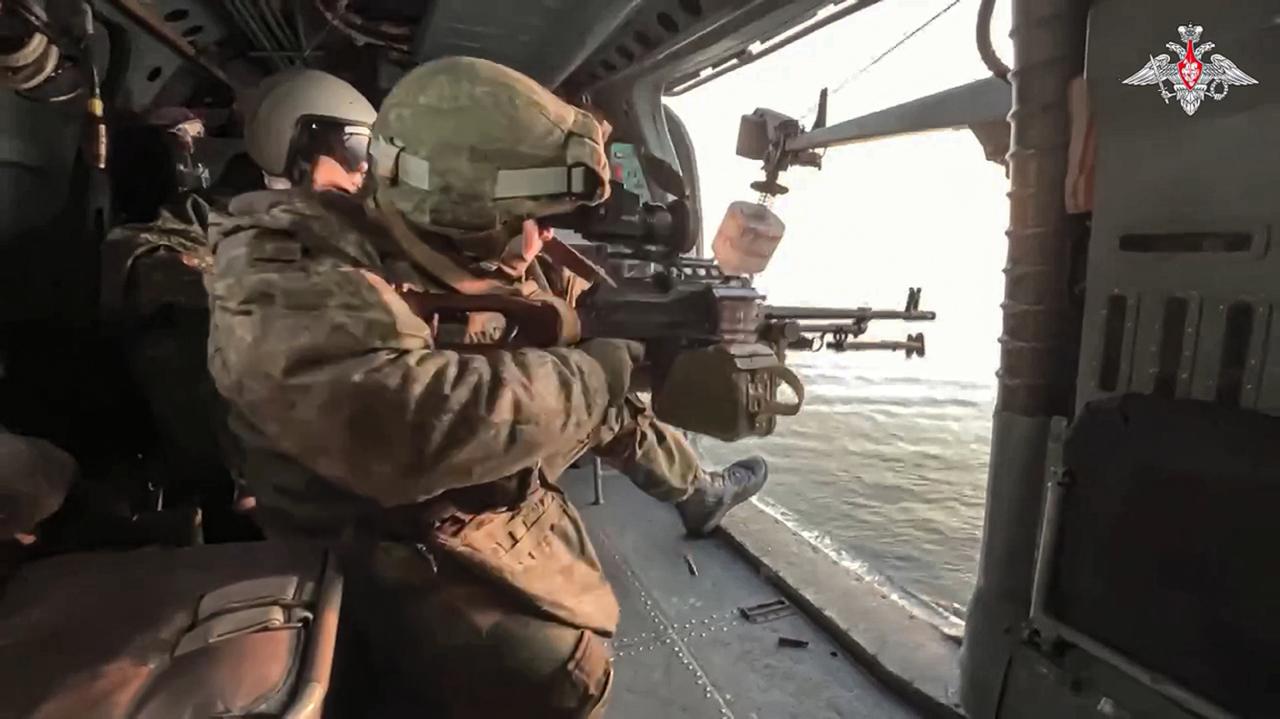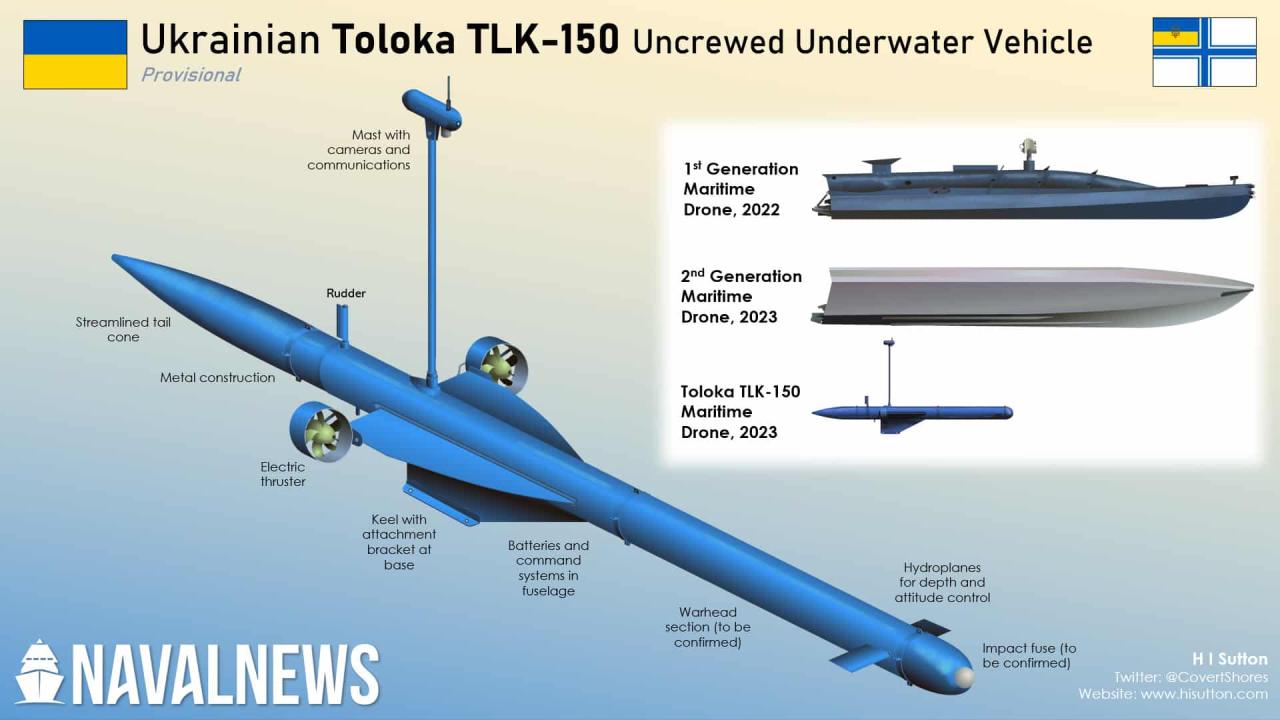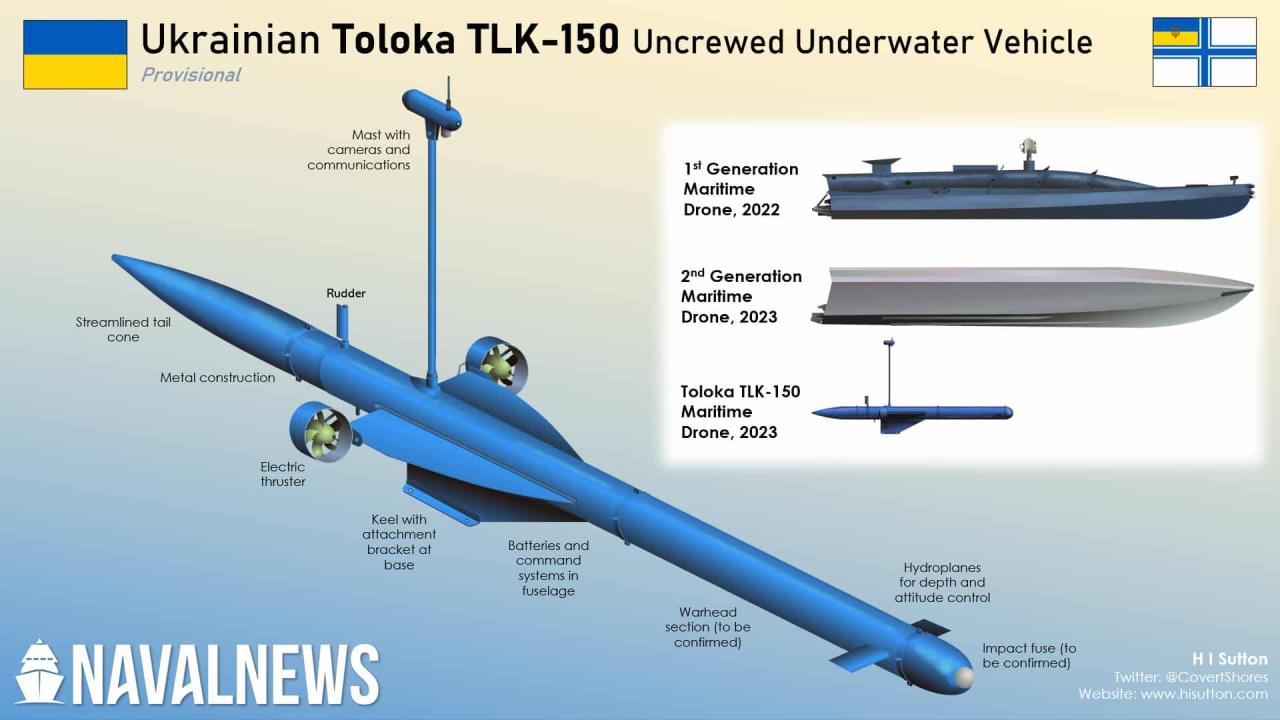Ukrainian sea drones are changing naval warfare. These unmanned vessels, ranging from small, expendable craft to more sophisticated autonomous systems, are proving surprisingly effective. This exploration delves into their technology, operational use, impact, and future potential, providing a comprehensive overview of this rapidly evolving field.
We’ll examine the diverse designs, from simple explosive-laden boats to more complex drones capable of reconnaissance and even targeted attacks. We’ll also analyze their strategic implications, exploring how they’re altering naval doctrines and the potential for escalation or de-escalation of conflict. The discussion will also touch upon the ethical considerations surrounding the use of autonomous weapons systems at sea.
Ukrainian sea drones are making waves, showcasing impressive autonomous capabilities in naval warfare. It’s a far cry from the dazzling spectacle of a drone show, like the amazing shanghai dragon drone show , but both highlight the diverse applications of drone technology. Ultimately, though, the Ukrainian sea drones represent a potent, if less visually stunning, form of military advancement.
Ukrainian Sea Drone Technology: A Deep Dive

Ukraine’s innovative use of unmanned maritime systems has significantly impacted modern naval warfare. This article explores the technological aspects, operational deployments, impact, future predictions, and illustrative examples of Ukrainian sea drones.
Technological Aspects of Ukrainian Sea Drones

Ukrainian sea drones encompass a variety of designs, adapted to different missions and operational environments. These range from smaller, simpler units for reconnaissance and coastal defense to larger, more sophisticated drones capable of carrying heavier payloads and operating at greater distances.
Ukrainian sea drones are making waves, proving their effectiveness in naval warfare. It’s interesting to compare their tactical applications to the sheer spectacle of a large-scale drone display, like the one seen at the shanghai drone show , where thousands of drones create breathtaking aerial formations. While vastly different in purpose, both highlight the rapid advancements and diverse uses of drone technology today, showcasing its potential impact across various fields.
- Types: The Ukrainian arsenal includes both surface and underwater drones, varying in size, payload capacity, and range. Some are purpose-built for specific tasks, such as anti-ship attacks, while others are more versatile.
- Technological Components: A typical Ukrainian sea drone incorporates a robust propulsion system (likely using electric motors for quiet operation), a sophisticated GPS/INS navigation system for accurate positioning and path planning, and a variety of payload options, including explosives, cameras, and sensors. Communication is likely achieved via satellite or other long-range links.
- Manufacturing and Supply Chain: The manufacturing process is likely decentralized, involving a network of domestic and potentially international suppliers. This distributed approach enhances resilience against attacks on centralized production facilities.
- Comparison to Other Nations: While lacking the sheer scale of drone production seen in some larger nations, Ukrainian sea drones demonstrate a remarkable cost-effectiveness and adaptability, showcasing a focus on innovative solutions using readily available components.
- Hypothetical Upgrade: A potential upgrade could focus on increasing range by incorporating more efficient propulsion systems and higher-capacity batteries. This would allow for longer missions and broader operational reach.
Operational Use of Ukrainian Sea Drones

The successful deployment of Ukrainian sea drones in recent conflicts highlights their tactical significance and operational effectiveness.
| Drone Type | Operational Cost (Estimate) | Effectiveness Metric (e.g., Targets Destroyed) | Advantages/Disadvantages |
|---|---|---|---|
| Small Reconnaissance Drone | $10,000 – $50,000 | High information gathering capability | Advantages: Low cost, high information gathering. Disadvantages: Limited payload, vulnerable to detection. |
| Medium Anti-Ship Drone | $50,000 – $200,000 | High damage potential against smaller vessels | Advantages: High damage potential against smaller vessels. Disadvantages: Limited range, vulnerability to countermeasures. |
| Large Multi-Role Drone | $200,000+ | Versatile, high payload capacity, extended range | Advantages: Versatility, high payload capacity, extended range. Disadvantages: High cost, complex operation, vulnerability to countermeasures. |
Data presented in the table is an estimate and may vary based on specific drone models and operational conditions.
- Successful Deployments: Reports indicate successful attacks against Russian naval vessels and infrastructure, demonstrating the drones’ effectiveness in asymmetric warfare.
- Strategic Advantages and Disadvantages: Sea drones offer advantages such as cost-effectiveness, low risk to human personnel, and the ability to strike targets in unexpected ways. Disadvantages include vulnerability to countermeasures, reliance on effective communication, and the potential for unintended escalation.
- Tactics and Procedures: Deployments likely involve coordinated swarms or individual attacks, depending on the mission objectives and available resources. Operators use sophisticated control systems to manage the drones remotely.
- Training and Expertise: Operators require training in drone operation, mission planning, and maintenance. Specialized skills are also needed to manage data from sensors and payloads.
Impact and Implications of Ukrainian Sea Drones
The emergence of Ukrainian sea drones has profound implications for naval warfare and international relations.
- Impact on Naval Warfare Strategies: The effectiveness of Ukrainian sea drones has forced navies to reconsider their defensive strategies and invest in countermeasures.
- Potential for Escalation or De-escalation: While the use of drones can lead to escalation, their low cost and potential for surgical strikes could also be used for de-escalation by targeting specific assets rather than engaging in broader conflicts.
- Geopolitical Implications: The widespread adoption of this technology could lead to a shift in naval power dynamics, empowering smaller nations with limited resources.
- Ethical Considerations: The autonomous nature of some sea drones raises ethical concerns about accountability and the potential for unintended harm to civilians.
- Hypothetical Future Conflict Scenario: A future conflict could see a large-scale deployment of Ukrainian sea drones coordinated with other military assets, potentially overwhelming the defenses of a larger adversary.
Future Developments and Predictions
The future of Ukrainian sea drone technology is marked by continuous innovation and development.
- Potential Future Developments: Increased autonomy, enhanced intelligence capabilities through AI, and greater payload capacity are likely areas of focus. Improved stealth features and countermeasure resistance will also be critical.
- Advancements in Autonomy, Intelligence, and Payload: AI and machine learning could enable drones to make more independent decisions, adapt to changing conditions, and select targets autonomously. Larger payloads could allow for greater destructive power or more sophisticated sensor packages.
- Countermeasures and Solutions: Navies are developing countermeasures such as electronic warfare systems and anti-drone weapons. Ukrainian developers will need to innovate to overcome these challenges.
- International Cooperation: International cooperation will be crucial in establishing regulations and norms for the development and use of autonomous maritime systems.
- AI and Machine Learning Integration: Future designs will likely incorporate advanced AI algorithms for improved target recognition, navigation, and decision-making.
Illustrative Examples
The following sections provide detailed descriptions of hypothetical scenarios, showcasing the capabilities and potential impact of Ukrainian sea drones.
- Hypothetical Attack: Imagine a swarm of ten small, fast sea drones, each carrying a small but powerful warhead, launched from a concealed location. These drones, guided by GPS and inertial navigation systems, converge on a large naval vessel, striking simultaneously below the waterline, causing significant damage and potential sinking. The drones are designed with a low radar signature, making them difficult to detect until they are very close to the target.
The visual elements would include the dark, sleek shapes of the drones slicing through the water, the sudden explosions, and the resulting chaos.
- Successful Mission Narrative: A single, larger Ukrainian sea drone, equipped with advanced sensors and a high-resolution camera, is deployed to gather intelligence on a suspected enemy base. The drone navigates a complex coastal environment, evading patrols and avoiding detection. The drone successfully transmits real-time video footage of the enemy activity, showing the intense sun glinting off the water, the rhythmic sounds of the drone’s propulsion, and the sharp image of the target base.
This intelligence is crucial in planning a subsequent offensive operation, ultimately resulting in a successful military objective.
Final Summary

Ukrainian sea drones represent a significant shift in naval power dynamics. Their relatively low cost, adaptability, and surprising effectiveness make them a potent tool in asymmetric warfare. While challenges remain, including countermeasures and ethical concerns, the future likely holds even more sophisticated and autonomous versions of these unmanned vessels, fundamentally reshaping how maritime conflicts are waged.
Answers to Common Questions
How are Ukrainian sea drones powered?
Ukrainian sea drones are making waves, showcasing impressive autonomous capabilities in naval warfare. Think of the coordinated precision of these drones, and then consider the breathtaking spectacle of a synchronized drone display, like the one you can see at the chinese dragon drone show. Both demonstrate the power of coordinated autonomous systems, though applied in very different contexts.
The advancements in drone technology evident in both the Ukrainian military application and the Chinese artistic performance are quite remarkable.
Power sources vary depending on the drone’s size and mission, but common options include electric motors powered by batteries or internal combustion engines.
What kind of payloads can they carry?
Payloads can range from explosives for attacks to cameras and sensors for reconnaissance. Some designs might even incorporate electronic warfare capabilities.
How are they controlled?
Control methods range from pre-programmed missions to remote control via satellite or other communication links. More advanced drones may possess a degree of autonomy.
What are the limitations of Ukrainian sea drones?
Limitations include range, vulnerability to countermeasures (like electronic jamming or anti-drone systems), and reliance on reliable communication links.
